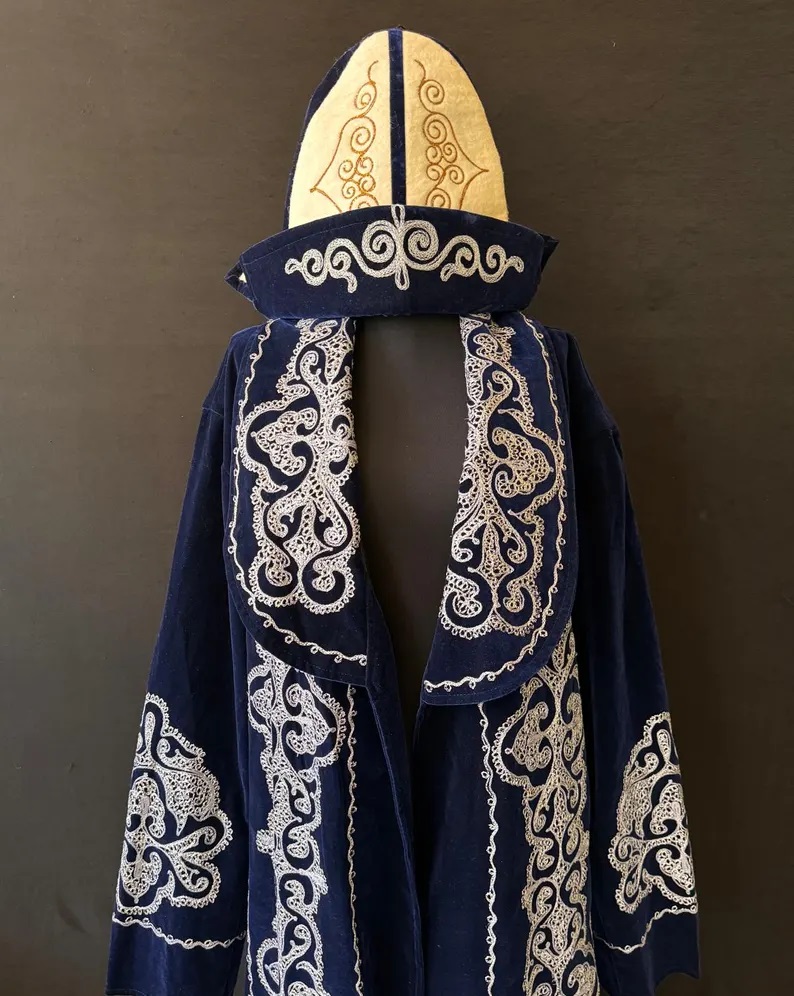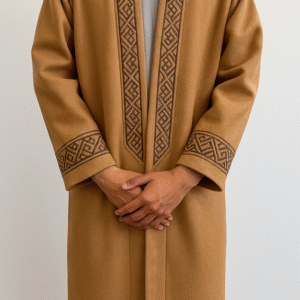Kazakh National Clothing / Robe for Men
$220.00
Cut: Loose cut – fits multiple sizes ( L, XL,XXL ).
Height: 137 cm (53.93 inches)
Armpit chest measurement: 69 cm (27.16 inches)
The Kazakh national robe for men, known as the shapan or chapan, represents one of Central Asia’s most iconic traditional garments. This magnificent long robe embodies centuries of nomadic culture and continues to be a symbol of Kazakh heritage and masculine elegance in modern times.
Historical Significance of the Kazakh Robe
The shapan holds profound cultural importance in Kazakh society. While men’s clothing in Kazakhstan consisted of simple components like shirts, pants, and hats, it was the “shapan” that was considered the most important item of clothing. This traditional robe served not only as practical outerwear for the harsh Central Asian climate but also as a status symbol reflecting the wearer’s social position and wealth.
Materials and Construction of Authentic Kazakh Shapan
Traditional Fabrics and Linings
Shapan robes are lined with a layer of wool or cotton, providing essential warmth for Kazakhstan’s continental climate. Chapans are made from various fabrics and are available in a range of colors, most often monochrome or dark.
Festive and Ceremonial Versions
Festive velvet chapans are decorated with appliqué, brushing, and gold embroidery. This type of robe was worn by wealthy Kazakhs. Festive shapan is sewn from velvet, decorated with applications and gold embroidery, making them suitable for special occasions and celebrations.
Special Types of Kazakh Robes
Traditional Kazakh clothing includes several variations of the shapan:
- Syrmaly: A chapan which is quilted and strengthened with denser fabric
- Qaptal: A lined chapan providing extra warmth
- Shabu: Another traditional variation mentioned in historical sources
Traditional Kazakh Embroidery and Decorative Elements
The artistic beauty of Kazakh men’s robes lies in their intricate decorative work. The expressiveness of the artistic language was manifested in Kazakh embroidery through ornamental forms of cosmogonic, geometric, plant and zoomorphic patterns. The most recognizable is the ornament in the form of a circle (tabaksha) found on clothes, particularly men’s shapans.
These embroidered patterns often carry deep cultural meanings, representing elements of nature, celestial bodies, and traditional Kazakh symbols that connect the wearer to their nomadic heritage.
How to Wear a Kazakh Shapan: Traditional Styling
The shapan robe was worn over a shirt and trousers, creating a layered look that was both practical and elegant. Traditional men’s clothing also included pants called shtany, boots, a belt, and a hat, completing the authentic Kazakh ensemble.
The robe’s loose-fitting design made it ideal for the nomadic lifestyle, allowing freedom of movement while horseback riding and providing protection from the elements.
Modern Relevance of Kazakh Traditional Robes
Today, the Kazakh shapan continues to play an important role in:
- Cultural celebrations and national holidays
- Wedding ceremonies and traditional festivities
- Folk performances and cultural presentations
- International cultural exchange events
- Fashion collections inspired by traditional Central Asian clothing
Reviews
There are no reviews yet.




Be the first to review “Kazakh National Clothing / Robe for Men”